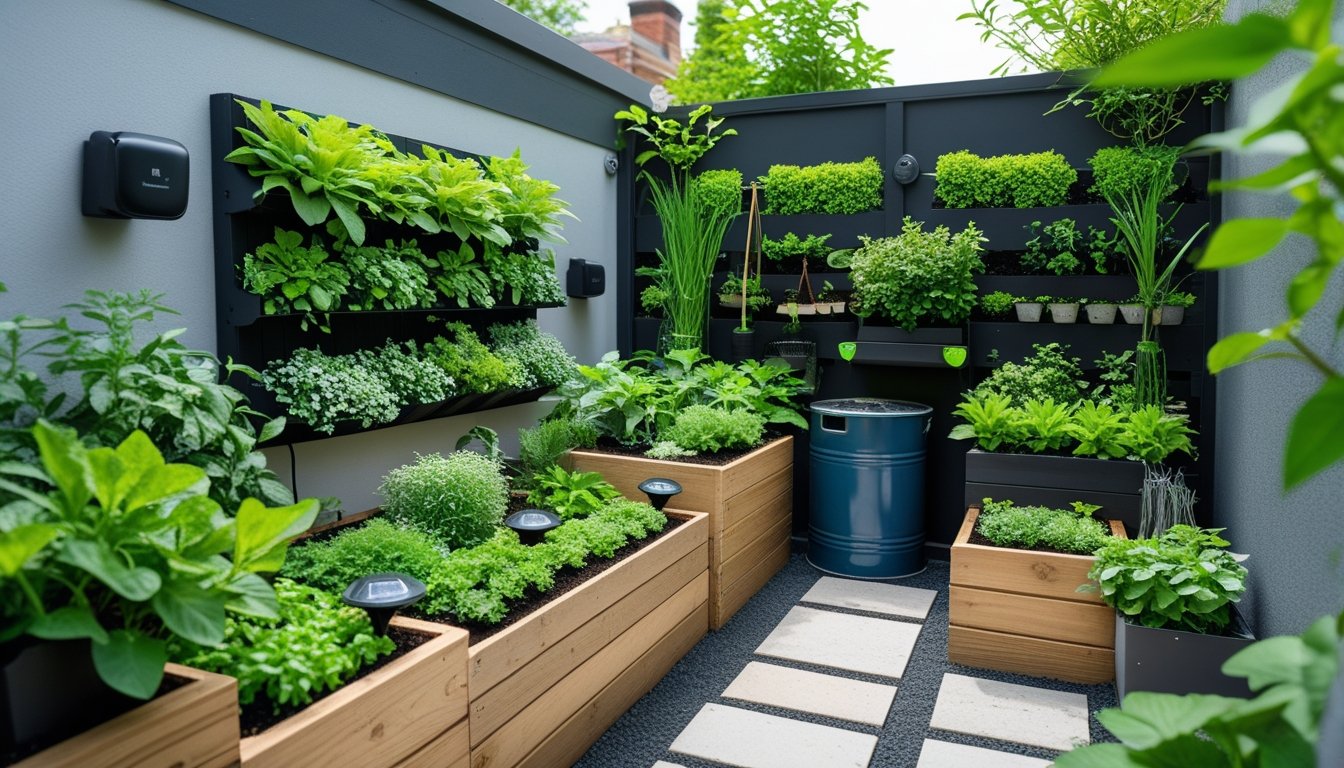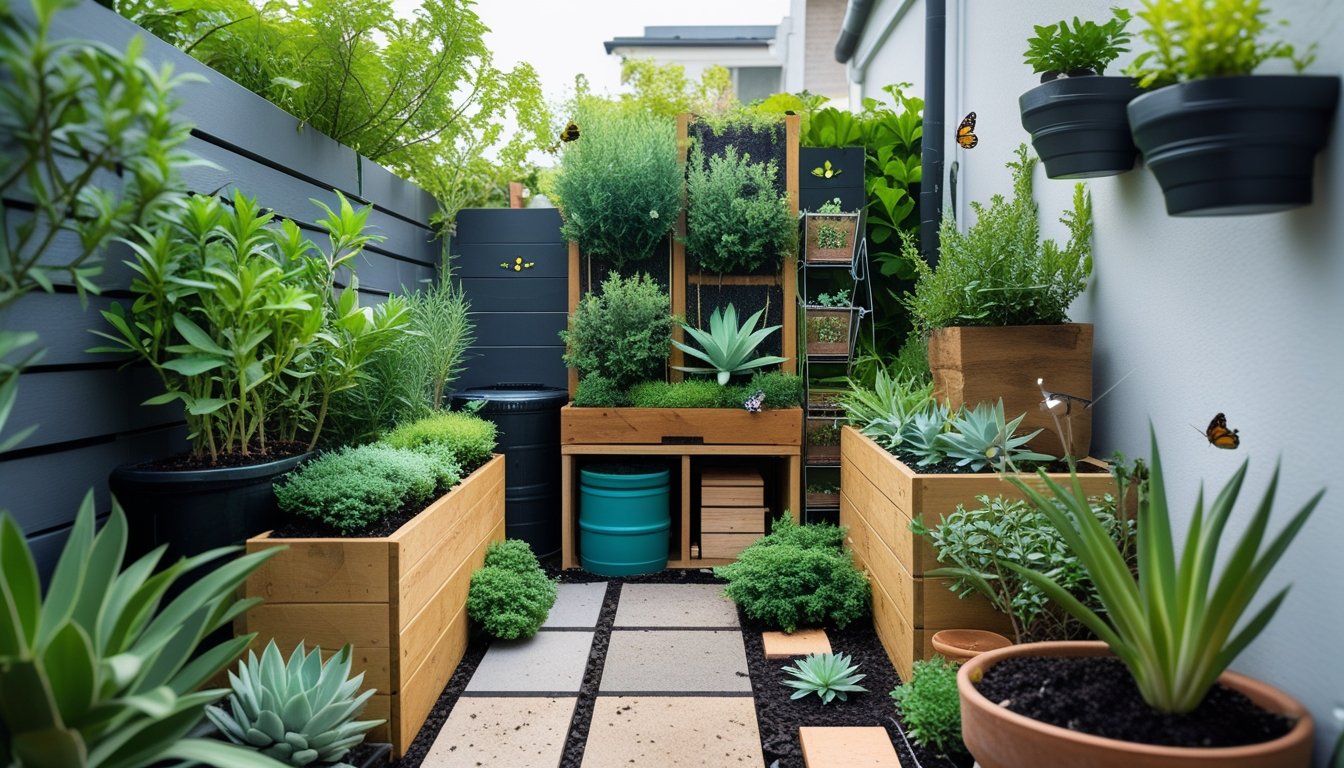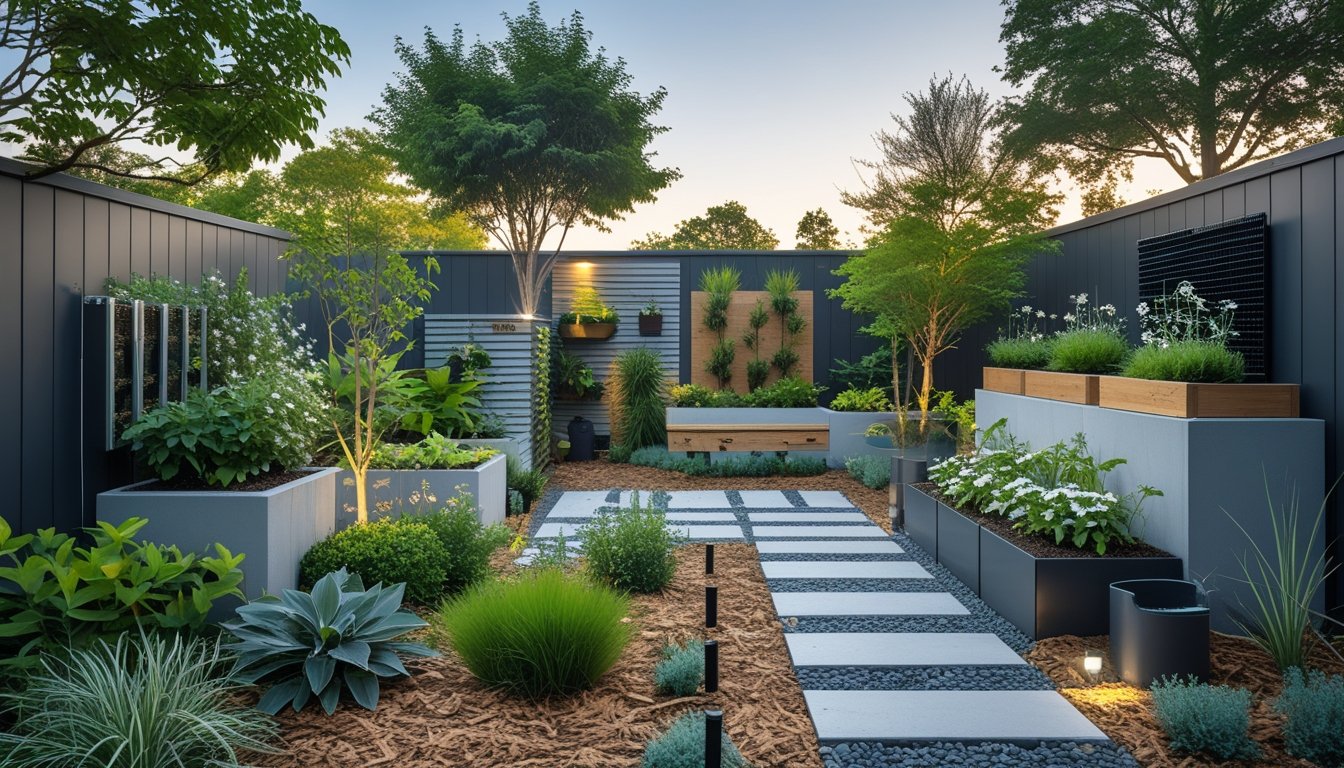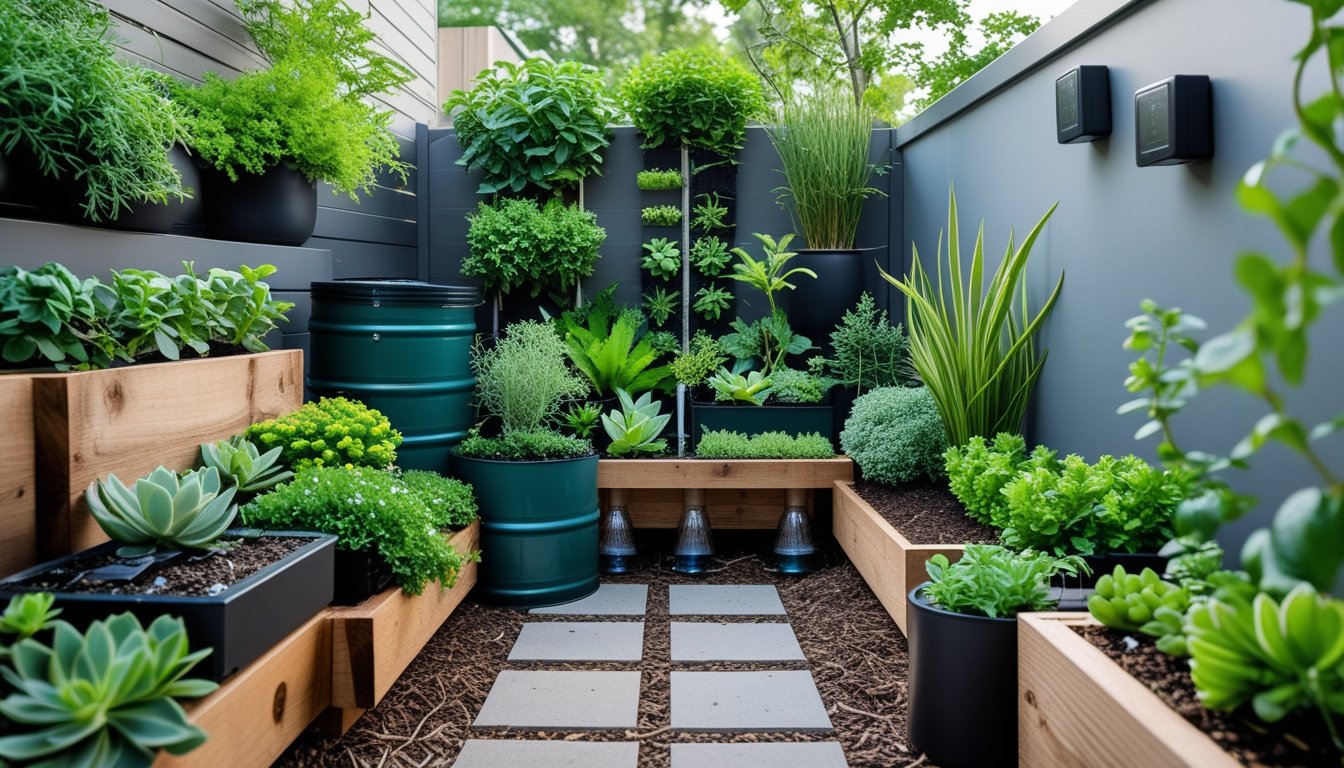Late updated: 31 Oct 2025 14:10
Written by: Sarah Hollister
Eco-Friendly Landscaping Ideas For Small Spaces: Maximising Greenery in Compact Areas
Small spaces don't have to hold us back from embracing eco-friendly landscaping. With thoughtful planning and creativity, we can transform even the tiniest garden into a lush, sustainable paradise. Our mission is to make every inch count, employing smart design principles and sustainable practices that benefit both us and the environment.

Imagine converting a modest balcony or a limited backyard into a vibrant green haven. Vertical gardening, water-wise containers, and native plants seamlessly blend beauty and sustainability. By choosing these options, not only do we enhance aesthetic appeal, but we also play a part in local biodiversity and resource conservation.
Eco-friendly landscaping is not just about aesthetics; it’s about fostering a healthier living space. Whether addressing soil health, reducing waste through composting, or creating multi-functional garden areas, each step contributes to a more sustainable lifestyle. With the right approach, small spaces can yield big environmental benefits.
Key Takeaways
- Transform small spaces with eco-friendly, creative landscaping.
- Use native plants and vertical gardens to maximise benefits.
- Focus on sustainable practices to enhance the environment.
Key Eco-Friendly Landscaping Ideas for Small Spaces

Transforming a small outdoor space into an eco-friendly haven involves imaginative use of available resources. Utilising vertical gardens, potted plants, and water-saving features can maximise space and minimise environmental impact. These strategies make it possible to create a beautiful and sustainable landscape, even in compact areas.
Maximising Greenery with Vertical Gardens
Vertical gardens are perfect for small spaces. They allow us to expand greenery upwards, using walls or special structures to create lush displays. This method is particularly suited to balconies or narrow yards.
Employing plants like ferns, ivy, or moss, which thrive in wall environments, can optimise both aesthetics and air quality. Pocket planters or wall-mounted pots are ideal for cultivating herbs and small flowering plants. With just a little sunlight and occasional watering, a vertical garden can flourish and make the most of limited space.
Utilising Potted Plants and Plant Stands
Potted plants are versatile, allowing us to incorporate green elements without the need for extensive ground space. Using a mix of pot sizes and plant types, we can create visual interest and flexibility in arrangement.
Plant stands add layers, making small spaces appear more dynamic. Elevating pots not only saves space but also enhances light exposure for healthier growth. Eco-friendly materials like recycled pots or sustainably sourced wood stands further contribute to an environmentally conscious approach. Together, pots and stands afford us endless possibilities in customising our green oasis.
Low-Maintenance Options: Succulents and Cacti
Succulents and cacti are ideal choices for those seeking low-care greenery. These plants require minimal watering and can thrive in smaller pots, making them perfect for compact spaces and busy lifestyles.
Their diverse shapes and colours add vibrant textures and richness. We can arrange these resilient plants on windowsills, tables, or shelves, integrating them into our existing decor. By grouping different varieties, a captivating and hardy garden can be developed, demonstrating beauty without demanding significant attention.
Creating Textural Impact with Pebbles and Driftwood
To enhance your garden's visual intrigue, integrate pebbles and driftwood strategically. Pebbles, available in various colours and sizes, can define pathways or act as a mulch substitute.
Driftwood, with its organic curves, provides a striking contrast to the greenery while serving as a backdrop or focal point. Together, these natural elements add textural depth and uniqueness to our garden. Arranging them thoughtfully transforms the space into a serene landscape influenced by natural beauty.
Water-Saving Features: Drip Irrigation and Water Fountains
Water management is essential in sustainable landscaping. Drip irrigation systems deliver moisture directly to plant roots, reducing waste and encouraging healthy growth. Even in small spaces, implementing such a system is both feasible and advantageous.
Garden fountains, when chosen carefully, can complement our eco-friendly objectives. Solar-powered models conserve energy, while their soothing sounds enhance our garden's ambience. Combining these features, we promote a balanced ecosystem, emphasising both aesthetics and water conservation.
Designing Sustainable, Multi-Functional Small Landscapes

When creating eco-friendly landscapes in limited spaces, we prioritise using native plants, integrating edible landscaping, adding purposeful structures, and including ornamental accents. Each step helps build a garden that is both sustainable and multifunctional.
Native Planting and Supporting Local Wildlife
In our small spaces, choosing native plants is essential. These plants are well-adapted to the local climate and require less water and maintenance compared to non-native species. By providing a natural habitat, they support local wildlife, including pollinators like bees and butterflies. For instance, planting native wildflowers can attract and sustain these critical insects.
Additionally, incorporating features such as birdhouses can attract different bird species. These elements not only enhance biodiversity but also add life and movement to our gardens. By helping local wildlife thrive, we create outdoor spaces that are not just beautiful but beneficial to the ecosystem.
Incorporating Edible Landscaping and Herbs
Edible landscaping allows us to combine aesthetics with functionality. By integrating edible plants like leafy greens, strawberries, or tomatoes, we enrich our gardens with fresh produce. Herbs such as rosemary and lavender offer aromatic and culinary benefits while being attractive additions.
Utilising vertical gardening techniques, we can maximise the use of limited space. By growing climbing plants like climbing roses on trellises, we save ground space and still produce abundant harvests. This approach is essential for urban settings where every square metre counts. With careful planning, our gardens become sources of nourishment and visual pleasure.
Small Space Structures: Pergolas and Privacy
Adding structures like pergolas enhances the functionality of our small landscapes. A wooden pergola can serve as a focal point and provide partial shade, creating a comfortable place to relax outdoors. When adorned with climbing plants, such as wisteria or ivy, pergolas contribute to a lush, verdant canopy.
Privacy is often a concern in compact spaces, and strategically placed pergolas or screens can help create intimate areas shielded from neighbours. These elements are not only practical but also add vertical interest to the garden. By integrating such structures, we make our outdoor spaces more versatile and inviting.
Ornamental Accents and Layered Planting
Ornamental accents, including ornamental grasses and carefully chosen planters, add texture and visual interest to our landscapes. These elements can define spaces and guide the flow within a garden. In small areas, selecting accents that complement the overall design ensures harmony without overwhelming the senses.
Layered planting involves using varying plant heights to create depth and perspective. By placing taller plants at the back and shorter ones at the front, we achieve a fuller, more vibrant look. This technique optimises space and enhances the garden's aesthetics, making it a cohesive and lively environment.
Frequently Asked Questions

Our focus here is on incorporating eco-friendly principles into small garden spaces, making the most of limited areas with sustainable choices. From selecting biodiversity-boosting plants to smart use of space with vertical gardening and appropriate materials for garden features, these questions aim to provide insights into sustainable landscaping.
What are some space-efficient plant choices for enhancing biodiversity in small gardens?
Choosing native plants is essential, as they adapt well to local conditions and support wildlife. Opting for a mix of flowering plants and herbs can attract beneficial insects like bees and butterflies. Compact shrubs and dwarf trees provide shelter and nesting areas for birds without overwhelming small spaces.
How can I implement a rainwater harvesting system in a compact outdoor space?
Utilising rain barrels is a practical solution. These barrels can be placed under downspouts to collect rainwater which can be used for watering plants. Slimline tanks are also useful for fitting into narrow spaces, and drip irrigation systems can distribute water efficiently.
What materials are best for creating durable and sustainable garden features in restricted areas?
Reclaimed wood and recycled materials are excellent choices, reducing waste and environmental impact. Permeable paving options, like gravel or permeable concrete, allow water to seep through, preventing runoff. Metal and glass accents can add aesthetic appeal while remaining environmentally friendly.
Could you suggest eco-friendly options for outdoor lighting in limited spaces?
Solar lights are an ideal option, as they require no wiring and use renewable energy. LED lights are energy efficient and have a longer lifespan compared to traditional bulbs. Motion-sensor lights can also be strategically positioned to provide illumination only when necessary.
What are the principles of xeriscaping, and how can they be applied to small urban gardens?
Xeriscaping focuses on water conservation. By using drought-tolerant plants and grouping plants with similar water needs, we can minimise water usage. Mulching helps retain soil moisture and reduces evaporation, making it a suitable choice for conserving water in urban gardens.
How can vertical gardening contribute to eco-friendliness in confined outdoor spaces?
Vertical gardening maximises space usage by allowing plants to grow upwards. It increases green coverage without expanding the footprint. Green walls or trellises can be utilised to grow trailing plants, herbs, or even vegetables, supporting biodiversity while enhancing aesthetics and air quality.
